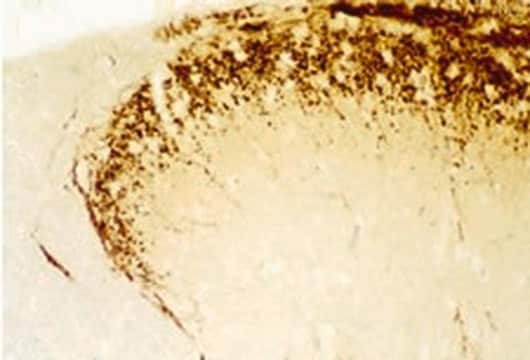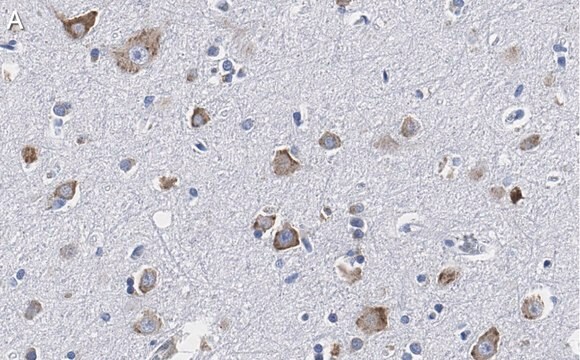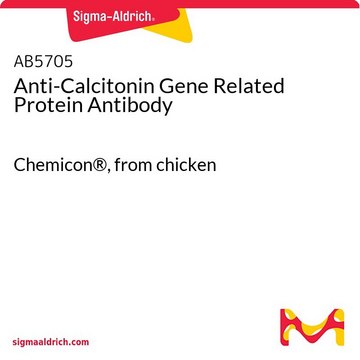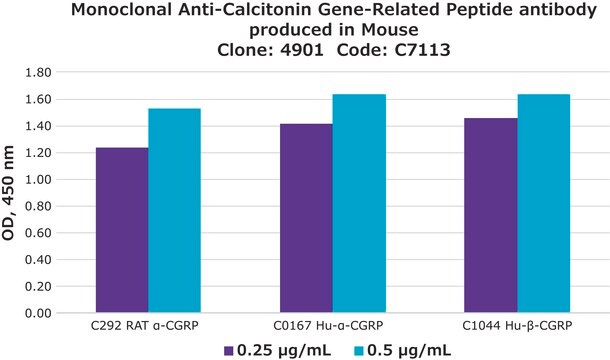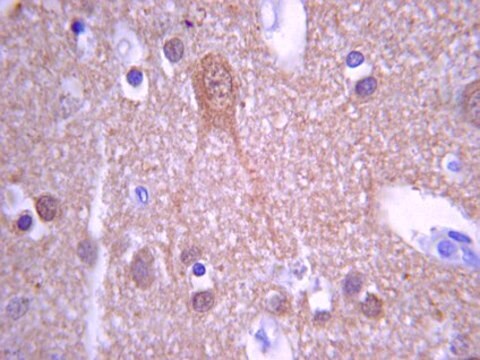AB15360
Anti-Calcitonin Gene Related Peptide Antibody
serum, Chemicon®
Synonim(y):
CGRP
Zaloguj sięWyświetlanie cen organizacyjnych i kontraktowych
About This Item
Kod UNSPSC:
12352203
eCl@ss:
32160702
NACRES:
NA.41
Polecane produkty
pochodzenie biologiczne
rabbit
Poziom jakości
forma przeciwciała
serum
rodzaj przeciwciała
primary antibodies
klon
polyclonal
reaktywność gatunkowa
rat
producent / nazwa handlowa
Chemicon®
metody
immunohistochemistry: suitable
numer dostępu NCBI
Warunki transportu
wet ice
docelowa modyfikacja potranslacyjna
unmodified
informacje o genach
human ... CALCA(796)
Specyficzność
Recognizes Calcitonin Gene Related Peptide (CGRP).
Immunogen
Synthetic calcitonin gene related peptide.
Zastosowanie
Anti-Calcitonin Gene Related Peptide Antibody detects level of Calcitonin Gene Related Peptide & has been published & validated for use in IH.
Immunohistochemistry on frozen rat spinal cord: 1:2,000-1:4,000 using the Chemicon IHC-Select Kit with HRP-DAB detection system.
Optimal working dilutions must be determined by the end user.
Optimal working dilutions must be determined by the end user.
Research Category
Neuroscience
Neuroscience
Research Sub Category
CNS Control of Metabolism
Hormones & Receptors
CNS Control of Metabolism
Hormones & Receptors
Powiązanie
Replaces: AB1971
Postać fizyczna
Rabbit serum. Liquid.
Serum
Przechowywanie i stabilność
Maintain at -20°C in undiluted aliquots for up to 12 months after date of receipt. Avoid repeated freeze/thaw cycles.
Informacje prawne
CHEMICON is a registered trademark of Merck KGaA, Darmstadt, Germany
Oświadczenie o zrzeczeniu się odpowiedzialności
Unless otherwise stated in our catalog or other company documentation accompanying the product(s), our products are intended for research use only and are not to be used for any other purpose, which includes but is not limited to, unauthorized commercial uses, in vitro diagnostic uses, ex vivo or in vivo therapeutic uses or any type of consumption or application to humans or animals.
Ta strona może zawierać tekst przetłumaczony maszynowo.
Nie możesz znaleźć właściwego produktu?
Wypróbuj nasz Narzędzie selektora produktów.
Kod klasy składowania
10 - Combustible liquids
Klasa zagrożenia wodnego (WGK)
WGK 1
Temperatura zapłonu (°F)
Not applicable
Temperatura zapłonu (°C)
Not applicable
Certyfikaty analizy (CoA)
Poszukaj Certyfikaty analizy (CoA), wpisując numer partii/serii produktów. Numery serii i partii można znaleźć na etykiecie produktu po słowach „seria” lub „partia”.
Masz już ten produkt?
Dokumenty związane z niedawno zakupionymi produktami zostały zamieszczone w Bibliotece dokumentów.
Expression of G protein-coupled receptor 30 in the spinal somatosensory system.
Keiko Takanami,Hirotaka Sakamoto,Ken-Ichi Matsuda,Koji Hosokawa,Mayumi Nishi et al.
Brain Research null
Andrea M Sartori et al.
Experimental neurology, 348, 113937-113937 (2021-11-27)
Neurogenic lower urinary tract dysfunction typically develops after spinal cord injury. We investigated the time course and the anatomical changes in the spinal cord that may be causing lower urinary tract symptoms following injury. Rats were implanted with a bladder
Maria N Marangoni et al.
Cardiovascular diabetology, 13, 11-11 (2014-01-15)
Cardiomyopathy and distal symmetrical polyneuropathy (DSPN), including sensory and autonomic dysfunction, often co-occur in diabetic mellitus (DM) patients. However, the temporal relationship and progression between these two complications has not been investigated. Using a streptozotocin DM animal model that develops
Aline Dionizio et al.
Chemosphere, 273, 129607-129607 (2021-01-29)
Gastrointestinal signs and symptoms are the first signs of toxicity due to exposure to fluoride (F). This suggests the possibility that lower levels of subchronic F exposure may affect the gut. The aim of this study was to evaluate changes
Michał Bulc et al.
Journal of diabetes research, 2018, 4735659-4735659 (2018-08-25)
One of the most frequently reported disorders associated with diabetes is gastrointestinal (GI) disturbance. Although pathogenesis of these complications is multifactorial, the complicity of the enteric nervous system (ENS) in this respect has significant importance. Therefore, this paper analysed changes
Nasz zespół naukowców ma doświadczenie we wszystkich obszarach badań, w tym w naukach przyrodniczych, materiałoznawstwie, syntezie chemicznej, chromatografii, analityce i wielu innych dziedzinach.
Skontaktuj się z zespołem ds. pomocy technicznej
